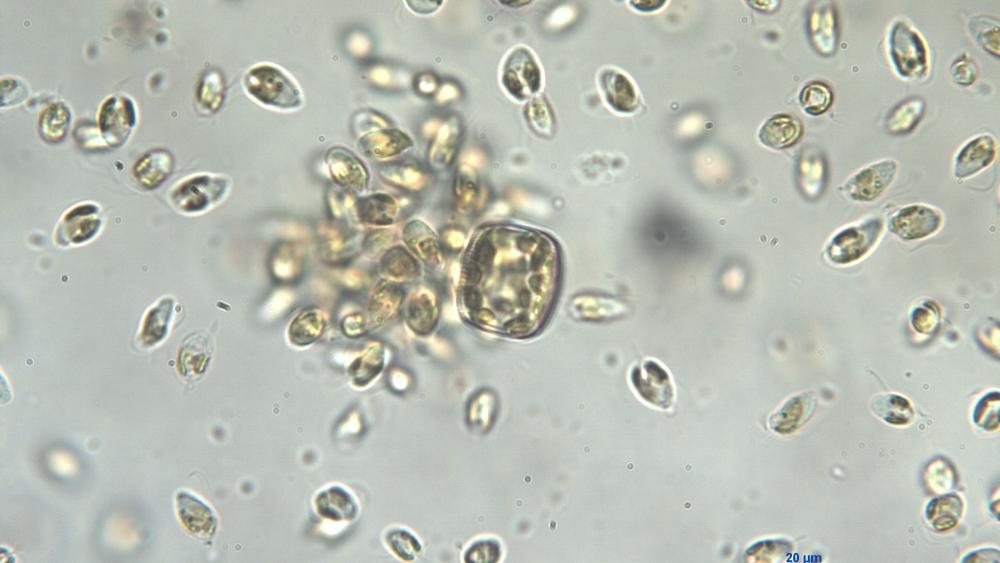
A swarm of prymnesia (from an IGB cell culture) infects a diatom. The microalgae lyse the other algae to absorb the dissolved cell contents. | Photo: Karla Münzner
Prymnesium parvum s.l. (sensu lato), commonly known as 'golden algae', stands for a whole group of microalgae which, although tiny at 5 to 10 micrometres in size, can cause devastating damage to ecosystems. This is because these algae can produce cytotoxins, so-called prymnesins. These destroy the gills of fish and filter-feeders such as mussels and snails and also attack other body tissues. The result: death due to lack of oxygen or circulatory failure.
Not all microalgae are the same
Previous studies on morphology and genetics have shown that Prymnesium parvum s.l. exhibits great diversity: it is a complex of at least 40 genetically distinct strains that differ in genome size and produce type-specific prymnesins as well as strain-specific mixtures of different prymnesin variants. Depending on toxin production, three clades are distinguished: A, B or C. To date, there has only been one reference genome, that of type A.
Close relationship between the microalgae ODER1 and brackish water strains from Denmark and Norway
As part of the ODER~SO project, an international team led by IGB researchers Dr Heiner Kuhl, Dr Jürgen Strassert, Prof Dr Michael Monaghan and PD Dr Matthias Stöck has now sequenced the entire genome of the Prymnesium parvum strain from the Oder catastrophe and identified gene sequences that are responsible for the chemical structure of the toxins and thus for their properties. The sequenced strain was named ODER1 and is a member of clade B.
The researchers also created a phylogenetic tree of various Prymnesium parvum strains. This shows that the ODER1 strain is most closely related to another type B strain, K-0081, which was isolated from brackish water in north-west Denmark in 1985, as well as to other type B strains from Norway (RCC3426, KAC-39 and K-0374). This similarity is due to the geographical proximity, but does not provide any direct information on how the alga reached the Oder.
Reference genome for monitoring algal blooms
Following the decoding of a type A reference genome and now the type B reference genome, two very different microalgae of the group have been covered; the decoding of the type C reference genome is still pending. "The decoding of the second reference genome of Prymnesium parvum s.l. provides important insights into the genetic basis and structural variability of the toxins. It has recently been shown that the prymnesin type influences toxicity. This means that we can now estimate the potential toxicity of future algal blooms much better", said IGB researcher Dr Jürgen Strassert, co-author of the study.
Next step: developing molecular methods of toxin analysis and investigating influencing factors
At present, toxin formation cannot be monitored directly. The toxin becomes too diluted to measure in the water and there are currently no standard methods, not even for clade A. "One of the IGB team's next steps will be to analyze toxin formation at the molecular level by determining the expression of specific toxin synthesis genes", added IGB researcher Dr. Heiner Kuhl, lead author of the study.
Environmental conditions play an important role in both the proliferation of the algal bloom and the production of toxins. "Decoding the genes for toxin production is therefore crucial for analyzing the environmental conditions under which the algae form these blooms and possibly produce specific toxins in different amounts", said IGB researcher Matthias Stöck, who led the study.
Environmental conditions play an important role in both the proliferation of the algal bloom and the production of toxins. "Decoding the genes for toxin production is therefore crucial in order to analyze the environmental conditions under which the algae tend to form these blooms and possibly produce specific toxins in different amounts", said IGB researcher Matthias Stöck, who led the study.

